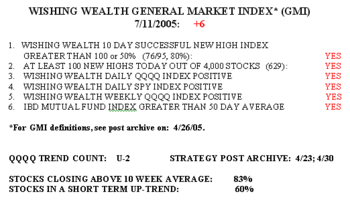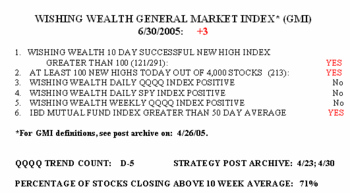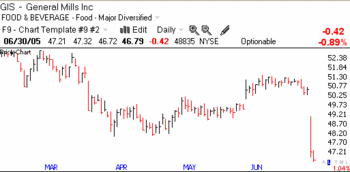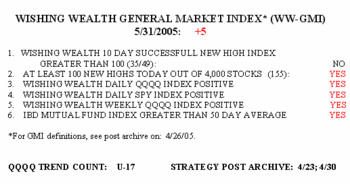To my visitors: I am only one trader, not a guru, and not a financial advisor. I am presenting my own opinions and my own experiences and people are welcome to decide for themselves what, if anything, on this site is of value to them. Please refer to the additional comments, highlighted in red, at the end of this post.
This is one hot market! There were 629 new highs (16%) in my universe of 4,000 stocks today.  The GMI remains at +6 and 83% of the stocks closed above their 10 week averages. I changed the criterion for the 10 day new high index to be positive if there were 100 successful stocks or at least 50% of the stocks that hit a new high 10 days ago closed higher today than 10 days ago. There were only 95 new highs 10 days ago, so the indicator would have had to be negative (less than 100) the way I originally defined the index. So today, 76/95 stocks or 80% qualified as successful 10 day new highs. 60% of the Nasdaq 100 stocks are in a short term up trend and 73% to 78% of the Nasdaq 100, S&P 500 and Dow 30 stocks rose today. These advancing percentages are lower than yesterday’s, but still very respectable……………………………………………
The GMI remains at +6 and 83% of the stocks closed above their 10 week averages. I changed the criterion for the 10 day new high index to be positive if there were 100 successful stocks or at least 50% of the stocks that hit a new high 10 days ago closed higher today than 10 days ago. There were only 95 new highs 10 days ago, so the indicator would have had to be negative (less than 100) the way I originally defined the index. So today, 76/95 stocks or 80% qualified as successful 10 day new highs. 60% of the Nasdaq 100 stocks are in a short term up trend and 73% to 78% of the Nasdaq 100, S&P 500 and Dow 30 stocks rose today. These advancing percentages are lower than yesterday’s, but still very respectable……………………………………………
I received a lot of nice reader feedback today–thank you!! I will address many of the issues you raised, in coming weeks………………………………………
I found a really neat description of a market scan used by a successful newsletter, Coolcat. Many of the stocks listed are those I have spotted. Note this scan for finding great microcaps uses some of the types of technical criteria I (and Nicolas Darvas) use to define rockets–new highs and huge price appreciation. As I wrote in my strategy posts on 4/23 and 4/30 (check the archive), to find a stock that will double, find one that has already doubled.
My rocket scan found loads of promising stocks today. All of these had triple digit earnings increases last quarter and are at new price peaks: CNXS, LUB, BOOM, NDAQ, TS, NTRI, BMHC, CPSI, LUFK, HANS, RIV, KOSP, SPTN, RTI, TU, PTRY, SNHY, HOLX, SE, WCG, TUG, PCO, VDSI, BEBE, SMTS. Check them out. When I buy strong momentum stocks like this, I make a small pilot buy and put a stop loss order in below support or below a moving average where it has found support. I then wait to see if it moves up and I slowly add more on the way up, as long as the GMI is strong……………………………..
Ever write a covered call in your IRA account? Today, I bought 100 shares of GOOG at 295.74. I then immediately sold a call for someone to buy my 100 shares from me at 300 per share, good through expiration on August 19. In return for the right to buy my GOOG from me at 300 during this period I was paid 15.80 per share, or $1580. What this means is that by option expiration in August, if GOOG is selling above $300, the option will be exercised and the stock will be called away from me for $300 per share. My profit (excluding commissions would be 30,000-29,574= +426 + 1580= $2006 or 7% in about 6 weeks. I am giving up the right to make anymore than this no matter how much above 300 that GOOG may climb during this period. On the other hand, if GOOG should decline during this period I would not have a loss until it fell to 279.94 (295.74-15.80). The option premium of 15.84 per share is mine to keep and protects me from a loss on my purchase down to 279.94. As long as GOOG closes above 279.94 by the August expiration I will have a profit. If GOOG closes below $300 in August, the option expires worthless and I can write a new call on the same shares for September or later. If the stock falls a lot more than 15.80, I could have a large loss.
Covered call writing is really a very conservative strategy. I only sell calls on stocks that I think will rise and which are so volatile that the option premium (amount someone will pay me for the option) is considerable. I do not want to buy GOOG without the protection of the covered call, so I do not care if the stock goes way above 300 by August. Check out covered call writing in the CBOE learning center. Many people of the "buy and hold" mentality could have limited their losses in 2000-2002 if they simply had written calls on their stocks as they declined. If you use a full service broker and s/he did not tell you about covered calls as your portfolio shrunk, you should liquidate your broker instead of your account.
Send me your feedback at: silentknight@wishingwealthblog.com.
Please remember that the stock market is a risky place, especially now. I am not providing recommendations for you to follow. My goal is to share tools and methods that I have used over the past 40 years of trading, so that you may learn from them and adapt them to your trading style and needs. While I do my best, I do not guarantee the accuracy of any statistics computed or any resources linked to my blog. Please consult with your financial adviser and a mental health practitioner before you enter the stock market, and please do not take unaffordable risks in the current market environment. See the About section for more statements designed to protect you (and me) as you navigate this market. Past performance does not guarantee future results, but I would rather learn from a former winner than a loser.


